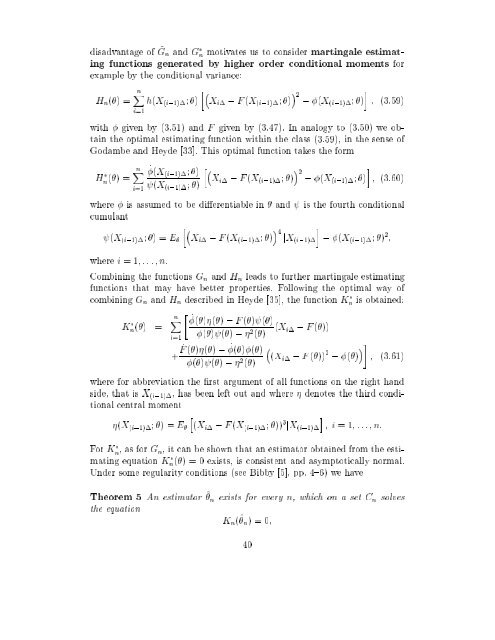Estimation in Financial Models - RiskLab
Estimation in Financial Models - RiskLab
Estimation in Financial Models - RiskLab
Create successful ePaper yourself
Turn your PDF publications into a flip-book with our unique Google optimized e-Paper software.
disadvantage of ~G n and G n motivates us to consider mart<strong>in</strong>gale estimat<strong>in</strong>g<br />
functions generated by higher order conditional moments for<br />
example by the conditional variance:<br />
H n () =<br />
nX <br />
2<br />
h(X (i,1) ; ) Xi , F (X (i,1) ; ) , (X(i,1) ; )<br />
i=1<br />
; (3.59)<br />
with given by (3.51) and F given by (3.47). In analogy to (3.50) we obta<strong>in</strong><br />
the optimal estimat<strong>in</strong>g function with<strong>in</strong> the class (3.59), <strong>in</strong> the sense of<br />
Godambe and Heyde [33]. This optimal function takes the form<br />
H n() =<br />
nX<br />
i=1<br />
_(X (i,1) ; )<br />
(X (i,1) ; )<br />
<br />
Xi , F (X (i,1) ; ) 2<br />
, (X(i,1) ; )<br />
; (3.60)<br />
where is assumed to be dierentiable <strong>in</strong> and is the fourth conditional<br />
cumulant<br />
(X (i,1) ; ) =E <br />
<br />
Xi , F (X (i,1) ; ) 4<br />
jX(i,1)<br />
<br />
, (X (i,1) ; ) 2 ;<br />
where i =1;:::;n.<br />
Comb<strong>in</strong><strong>in</strong>g the functions G n and H n leads to further mart<strong>in</strong>gale estimat<strong>in</strong>g<br />
functions that may have better properties. Follow<strong>in</strong>g the optimal way of<br />
comb<strong>in</strong><strong>in</strong>g G n and H n described <strong>in</strong> Heyde [35], the function Kn is obta<strong>in</strong>ed:<br />
" nX _()() , F () ()<br />
Kn() =<br />
(X<br />
() () , 2 i , F ())<br />
()<br />
i=1<br />
F<br />
+ _ ()() , ()() _ # (Xi , F ()) 2 , () ; (3.61)<br />
() () , 2 ()<br />
where for abbreviation the rst argument of all functions on the right hand<br />
side, that is X (i,1) , has been left out and where denotes the third conditional<br />
central moment<br />
(X (i,1) ; ) =E <br />
h<br />
(Xi , F (X (i,1) ; )) 3 jX (i,1)<br />
i<br />
; i =1;:::;n:<br />
For K n, as for G n , it can be shown that an estimator obta<strong>in</strong>ed from the estimat<strong>in</strong>g<br />
equation K n() =0exists, is consistent and asymptotically normal.<br />
Under some regularity conditions (see Bibby [5], pp. 4{6) we have<br />
Theorem 5 An estimator ^ n exists for every n, which on a set C n solves<br />
the equation<br />
K n (^ n )=0;<br />
40
















